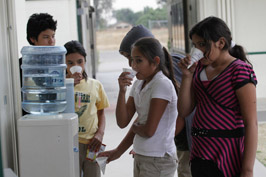By PATRICIA LEIGH BROWN / THE NEW YORK TIMES
November 13, 2012

Fifth and sixth grade students in Seville, Calif., took a water break before physical education class. Photo by Jim Wilson/The New York Times.
SEVILLE, Calif. — Like most children, the students at Stone Corral Elementary School here rejoice when the bell rings for recess and delight in christening a classroom pet.
But while growing up in this impoverished agricultural community of numbered roads and lush citrus orchards, young people have learned a harsh life lesson: "No tomes el agua!" — "Don't drink the water!"
Seville, with a population of about 300, is one of dozens of predominantly Latino unincorporated communities in the Central Valley plagued for decades by contaminated drinking water. It is the grim result of more than half a century in which chemical fertilizers, animal wastes, pesticides and other substances have infiltrated aquifers, seeping into the groundwater and eventually into the tap. An estimated 20 percent of small public water systems in Tulare County are unable to meet safe nitrate levels, according to a United Nations representative.


